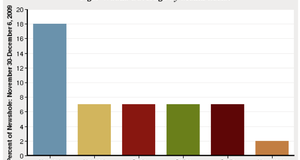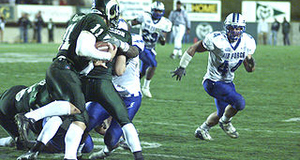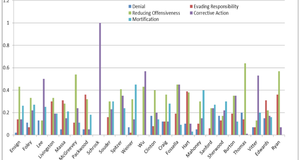From Elon Journal of Undergraduate Research in Communications VOL. 6 NO. 2Image Repair and Crisis Response of Professional Athlete Adrian PetersonIV. MethodsAdrian Peterson's statements will be the chief focus of this study. Qualitative content analysis was used as the best way to scrutinize this incident because the statements in media articles are non-biased and the most accurate descriptors of each response. This study used Benoit's image repair discourse framework to analyze Peterson's statements and how they affect the image repair process. Benoit's image repair discourse, the most recent image repair theory, has been used to analyze many other prominent image repair cases (Utsler & Epp, 2013, p. 147). This discourse is made up of 5 core strategies — denial, evasion of responsibility, reduction of offensiveness, corrective action, and mortification — and 12 subcategories — simple denial, blame shift, provocation, defeasibility, accidental, good intentions, bolstering, minimization, differentiation, transcendence, attacking accuser, and compensation (Holtzhausen & Roberts, 2009, p. 168). The Peterson case offered two sources of information: the statement that was addressed to the media and the police report that was released to the media. Peterson has attempted to address the incident and repair his image through these statements. This study analyzed each statement from these two sources to determine which of Benoit's image repair theory was used, even though they were limited. Peterson has been generally silent on the issue, most likely to avoid additional scrutiny on this ongoing incident. The effectiveness of Peterson's image repair strategies were analyzed through Benoit's "Appropriateness and Effectiveness of Image Repair Strategies." V. Findings and DiscussionThere are two sources of statements that Adrian Peterson made during the timespan of the incident: a police report and a media statement. Police ReportsThe New York Daily News reported part of the police report. According to the report, he used two of the main image repair strategies with four subcategories: evasion of responsibility with the subcategories of accident, good intentions and defeasibility; and reducing offensiveness with transcendence. According to the report, Peterson believed he did nothing wrong — evasion of responsibility for his offensive actions. This statement demonstrates that he either believes what he did was an accident or that the event in itself was done with good intentions. This statement was paired with a quote from Peterson: "Anytime I spank my kids, I talk to them before, let them know what they did, and of course after" (Myers, 2014). This also demonstrates that Peterson used the reduce offensiveness strategy in combination with evasion of responsibility. In his attempt to reduce offensiveness he used transcendence to paint his actions in a more positive light by claiming that he was simply disciplining his child because he is a good parent. Next, Peterson stated that he regretted that his son did not cry because it would have indicated that the switch had done more damage than intended (Myers, 2014). This is evasion of responsibility through defeasibility. Essentially he was saying that during the moment he lacked the information to determine whether he took his discipline too far. Peterson continued his evasion of responsibility by stating that he would not have let his child go back to Minnesota to see the doctor knowing his actions were wrong (Myers, 2014). This is also considered defeasibility because it is suggesting he had a lack of information and did not realize he had abused his child. In the final statement that was released in the police report, Peterson says, "I feel very confident with my actions because I know my intent" (Myers, 2014). During this period, Peterson asserted to his audience that he acted with good intentions and, therefore, did not commit any offensive act. Peterson's strategy is clear in the police report, but his game plan evolved further in the statement to the media by combining additional strategies. Media StatementIn September 2014, Adrian Peterson issued his initial statement to the media, a chief statement in his image repair strategy addressing the incident in depth. In this statement Peterson used mortification, reducing offensiveness, evasion of responsibility, and corrective action along with many of their subcategories. Peterson began his image repair strategy near the beginning of the statement by using the mortification approach. He stated, "I want everyone to understand how sorry I feel about the hurt I have brought to my child" ("Full Statement," 2014). Mortification is a strong beginning to his statement because it is the most honest strategy and has been the most effective in past image repair attempts (Borden 2012). Peterson follows up this strategy by stating that he "never imagined being in a position where the world is judging [his] parenting skills or calling [him] a child abuser because of the discipline [he] administered to [his] son" ("Full Statement," 2014). This statement alluded that this incident was an accident and that good intentions were involved. He hints at his perception of himself as a parent by stating that he is surprised that his discipline practices have caused him to be labeled as a child abuser. The next portion of his statement applies the evasion of responsibility strategy: "I voluntarily appeared before the grand jury several weeks ago to answer any and all questions they had. Before my grand jury appearance, I was interviewed by two different police agencies without an attorney. In each of these interviews, I have said the same thing, and that is that I never ever intended to harm my son. I will say the same thing once I have my day in court" ("Full Statement," 2014). By attributing the child abuse to an accidental occurrence, Peterson tried to evade responsibility for his actions. He strived to illustrate his honesty in the issue by saying that he spoke to law enforcement without his attorney. This implies that he believed he had nothing to hide and had good intentions in disciplining his son. He continued his good intentions strategy while providing an additional strategy in the next section of the statement: "I have to live with the fact that when I disciplined my son the way I was disciplined as a child, I caused an injury that I never intended or thought would happen. I know that many people disagree with the way I disciplined my child. I also understand after meeting with a psychologist that there are other alternative ways of disciplining a child that may be more appropriate" ("Full Statement," 2014). He combined defeasibility with his good intentions argument by claiming he didn't know better and that was the way he was raised. Additionally, he claimed that he had taken corrective action to try to improve or change the way he disciplined his children. He continued his corrective action approach at the beginning of the next section of his statement saying, "I have learned a lot and have had to reevaluate how I discipline my son going forward" ("Full Statement," 2014). This reinforced his claims to change his way of discipline and hopes to persuade the public and law enforcement that another incident of abuse will be avoided. Continuing to strengthen his image repair, he added the reducing offensiveness strategy: "But deep in my heart I have always believed I could have been one of those kids that was lost in the streets without the discipline instilled in me by my parents and other relatives. I have always believed that the way my parents disciplined me has a great deal to do with the success I have enjoyed as a man" ("Full Statement," 2014). In reducing offensiveness of his actions, he first used bolstering to focus the attention on his past. He tried to illustrate the positive effects of strong discipline that he was subject to in his youth that kept him on the right path. He attributed this type of discipline as the reason for his success as an adult, which was employed to reduce the negative perception of his current actions. Next, Peterson came back to the corrective action strategy and stated, "I love my son and I will continue to become a better parent and learn from any mistakes I ever make" ("Full Statement" 2014). This illustrated his love for his son as the motivation for taking corrective action. The hope is that the audience can relate to the emotion of loving their children, which in turn enhances this strategy as an image repair tool. His statement concluded by repeating some of the strategies that have already been used. He referred back to his evasion of responsibility strategy that claimed he lacked information on a better way to discipline, the incident was accidental, he had good intentions, and he will take corrective action. These strategies were executed by stating that he is not a perfect individual, he hoped to teach his son right from wrong, and his love for his son will drive him to become a better father and person. Effectiveness of StrategyPeterson used a variety of strategies in the statements in response to his child abuse case. Among his many strategies were corrective action and mortification strategy, which Benoit found to be the most effective image repair strategies. In order to issue a sincere apology these strategies are essential and only served Peterson's statements in a positive way. It should be noted that corrective action and mortification were not used until he issued his initial statement to the media. The most consistent strategy that Peterson used in both the police report and his initial statement was evasion of responsibility strategy. He constantly tried to remind his audience that he had good intentions, it was an accident, and he didn't know a different way to discipline. This strategy did not rank as high as mortification or corrective action, but was somewhat effective for image repair. According to Benoit's "Appropriateness and Effectiveness of Image Repair Strategies" scale, in Peterson's case, using evasion of responsibility as a main strategy in the bulk of his statements was less effective than if he had used corrective action and mortification strategies as the main points of emphasis. Transcendence and bolstering were used to reduce the offensiveness of his actions. Transcendence was ranked as a mid-level strategy, while bolstering was found to be least effective in Benoit's study. In his case, bolstering was the only low ranked strategy that he used and may have only hurt his case minutely according to Benoit's "Appropriateness and Effectiveness of Image Repair Strategies." VI. ConclusionWith the Adrian Peterson case being a current and ongoing topic, it was difficult to tell whether his strategy was effective. The length it takes to repair one's image generally varies for each case. Those that have committed offensive actions make multiple statements to repair their image, but it does not immediately restore their reputation. Most of the time it doesn't require words but rather action and time to heal. Peterson only used one main statement to the media, and his testimony in the police report was also released to the public. Only having one main statement to the media over a course of several months may serve as strategy for Peterson in itself. By being generally inactive in the media, it seems as if Peterson is hoping to be hidden from the public eye so that the healing power of time can begin to take its effect. In addition, Peterson may also be cognizant that many times in a situation such as this, image repair statements must be paired with actions to fix a damaged reputation. Through his general silence in the media on the subject of his child abuse case, he may be allowing himself time to work on improving his own character as well as showing his commitment to forgiveness through actions. Benoit's study on the "Appropriateness and Effectiveness of Image Repair Strategies" was used to analyze the effectiveness of Peterson's statements. It was found that Peterson used the strategies of mortification, corrective action, and evasion of responsibility as the focal point of his campaign, which are all high-ranking strategies according to the study. While this is a good indicator of whether Peterson used good strategy, it does not necessarily indicate whether or how much his reputation was protected. The only thing that can be measured is whether damage was done to Peterson's reputation. This can be seen through his loss of six sponsors, including his endorsement with Nike and NFLshop.com, the official gear provider of the NFL, discontinuing the sale of Peterson's jersey (Rovell, 2014). This case study has limitations because the issue is ongoing, so it is difficult to measure the status of his reputation. This study applied Benoit's case study on "Appropriateness and Effectiveness of Image Repair Strategies" for analysis of this topic, but his case study was not based on a case that is similar to Peterson's situation, nor on multiple cases that bolster a big theory that can be applied widely. Future case studies, such as this one, should allow more time between the onset of the situation and when it is analyzed so that enough information can be collected to determine whether a reputation has been effectively repaired. AcknowledgmentsThe author would like to thank Michael Frontani, associate professor of communications at Elon University, for his guidance throughout the process of creating this article, without which the article could not be published. The author also appreciates the numerous reviewers who have helped revise this article. AuthorRyan Winters, Strategic Communications, Elon University ReferencesBenoit, W. L., & Drew, S. (1997) Appropriateness and effectiveness of image repair strategies. Communication Reports 10.2: 153-163. Retrieved April 29, 2015 From, Communication & Mass Media Complete Bien, L. (2014, September 17). What is the nfl exempt/commissioner's permission list, and what does it mean for adrian peterson?" SBNation. Retrieved September 17, 2014, from SBNation.com Borden, S. L. (2012). Press apologias: a new paradigm for the new transparency?. Journal Of Mass Media Ethics 27.1: 15-30. Communication & Mass Media Complete. Web. 6 Apr. 2015. Retrieved April 6th, 2015, from Communication & Mass Media Complete Brown, K. A. (2012). Off the field: an empirical examination of the impact of athlete transgressions and response strategy on the image repair and crisis communication process. Retrieved March, 2015, from http://acumen.lib.ua.edu/content/u0015/0000001/0001043/u0015_0000001_0001043.pdf Brown, K. A., Dickhaus, J., & Long, M. C. (2012). LeBron james and "the decision": an empirical examination of image repair in sports. Journal of Sports Media 7.1: 149-175. Project MUSE. Retrieved April 6, 2015, from https://muse.jhu.edu/ DiMatteo, S. (2014, September 17). A timeline of the adrian peterson child abuse case. SBNation. Retrieved April 6, 2015, from SBNation.com "Full Statement from Minnesota Vikings Running Back Adrian Peterson." (2014, September 15). USA Today. Retrieved April 29, 2015, from http://www.usatoday.com/story/sports/nfl/vikings/2014/09/15/full-statementfrom-minnesota-vikings-running-back-adrian-peterson/15678171/ Holtzhausen, D. R., and Roberts, G. F. "An Investigation Into The Role Of Image Repair Theory In Strategic Conflict Management." Journal Of Public Relations Research 21.2 (2009): 165-186. Communication & Mass Media Complete. Web. 6 Apr. 2015. Retrieved April 6, 2015, from Communications & Mass Media Complete Myers, G. (2014, September 12). Myers: roger goodell should throw adrian peterson out of NFL after child abuse indictment." NY Daily News. Retrieved April 30th, 2015, from http://www.nydailynews.com/sports/football/myers-roger-goodell-throw-adrian-peterson-league-child-abuse-indictment-article1.1938241 Rovell, D. (2014, September 17). Nike suspends adrian peterson deal. ESPN. Retrieved April 29th, 2015, from http://espn.go.com/nfl/story/_/id/11542737/nike-suspends-adrian-peterson-endorsement-contract Utsler, M., & Epp. (2013) Image repair through tv : the strategies of mcgwire, rodriguez and bonds. Journal of Sports Media 8.1: 139-161. Project MUSE. Retrieved April 6th, 2015, from https://muse.jhu.edu/ Vensel, M. (2014, December 13) Adrian peterson's appeal denied. Star Tribune. Retrieved April 6th, 2015, from StarTribune.com Zinser, L. (2014, November 4) Adrian peterson agrees to plea deal in child-abuse case The New York Times. Retrieved April 6th, 2015 from http://www.nytimes.com Suggested Reading from Inquiries Journal
Inquiries Journal provides undergraduate and graduate students around the world a platform for the wide dissemination of academic work over a range of core disciplines. Representing the work of students from hundreds of institutions around the globe, Inquiries Journal's large database of academic articles is completely free. Learn more | Blog | Submit Latest in Business & Communications |



















